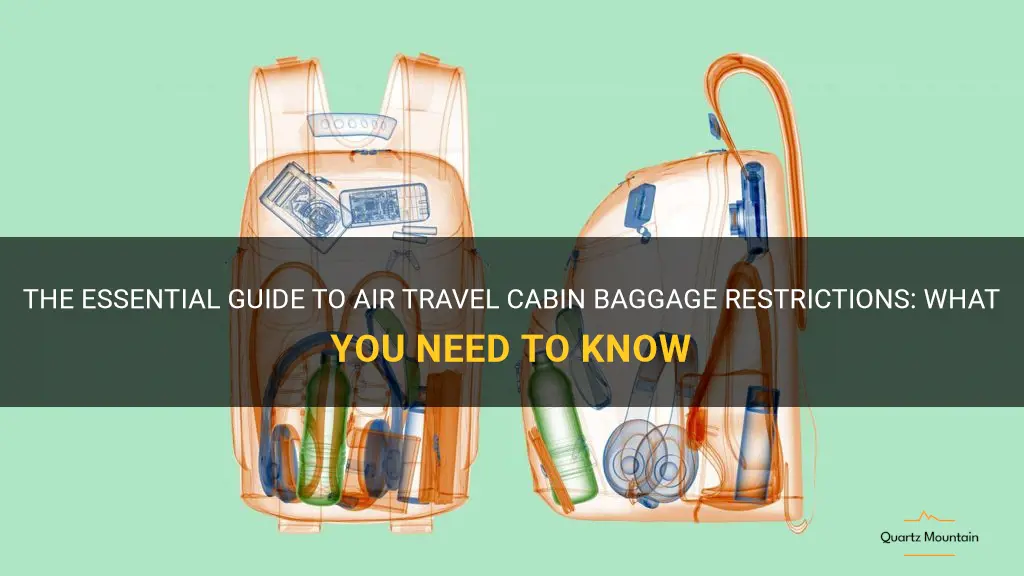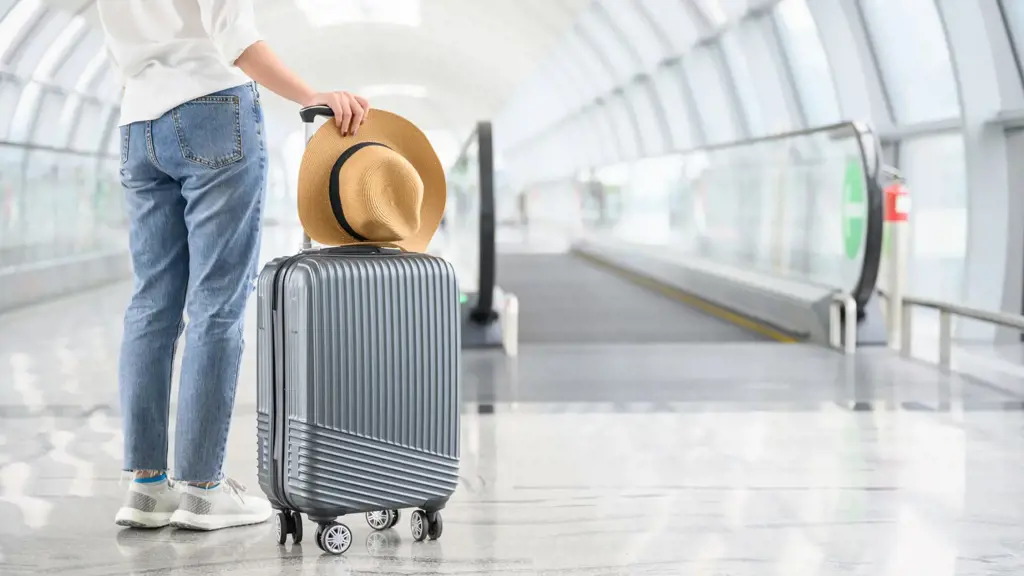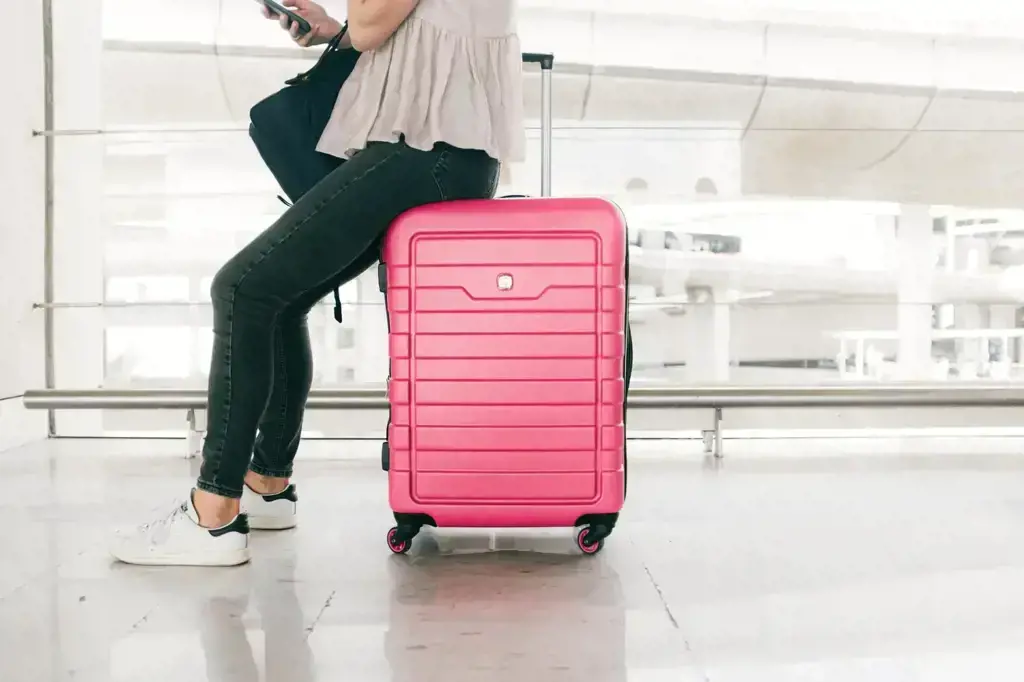
Air travel has revolutionized the way we explore the world, opening up new horizons and connecting distant destinations like never before. However, along with the convenience and speed of air travel comes the challenge of packing efficiently within the restrictions imposed by cabin baggage limits. Airlines have imposed various regulations and restrictions on the size, weight, and contents of carry-on luggage, aiming to ensure passenger safety, optimize flight operations, and make the most of limited cabin space. Understanding and adhering to these restrictions is crucial for any traveler hoping to make the most of their flying experience and breeze through security checks without any hassle.
What You'll Learn
- What are the current cabin baggage restrictions for air travel?
- How much weight is allowed for cabin baggage on most airlines?
- Are there any restrictions on the size or dimensions of carry-on luggage?
- Can passengers bring liquids in their cabin baggage, and if so, what are the restrictions?
- Are there any specific items that are prohibited from being brought in cabin baggage?

What are the current cabin baggage restrictions for air travel?

Cabin baggage restrictions for air travel vary depending on the airline and the country of departure. However, there are some general guidelines that most airlines adhere to in order to ensure the safety and comfort of all passengers on board.
The International Air Transport Association (IATA) sets out some recommended guidelines for cabin baggage size and weight, but it is ultimately up to each individual airline to determine their own restrictions. Most airlines have a limit on the size and weight of both carry-on bags and personal items.
For carry-on bags, the typical maximum dimensions are around 22 x 14 x 9 inches (56 x 36 x 23 cm). However, it's important to note that this can vary, so it's always best to check with the airline you'll be traveling with before packing your bags. Some low-cost airlines may have even stricter size restrictions.
Weight restrictions also vary between airlines, but most allow passengers to bring a carry-on bag that weighs up to 22 pounds (10 kilograms), although this can be as low as 15 pounds (7 kilograms) for certain regional flights. Again, it is essential to check with your specific airline to confirm their weight limits.
In addition to the carry-on bag, most airlines allow passengers to bring a personal item onboard, such as a handbag, laptop bag, or small backpack. The dimensions for personal items are usually smaller than those for carry-on bags, typically around 18 x 14 x 8 inches (45 x 35 x 20 cm). This item must fit under the seat in front of you.
There are also restrictions on what items can be brought onboard. This includes liquids, gels, and aerosols, which must be packed in containers of 3.4 ounces (100 milliliters) or less and placed in a clear, resealable plastic bag. Each passenger is usually limited to one quart-sized bag.
Other prohibited items in carry-on luggage include sharp objects, firearms, explosives, and flammable materials. It's important to review the specific guidelines for the airline and country you'll be traveling with to ensure you're not bringing any restricted items.
It's also worth noting that some airlines have additional restrictions for certain flights, such as those to or from the United States. These may include enhanced security measures or further limitations on the size and weight of cabin baggage.
To avoid any issues at the airport, it's always a good idea to check with your airline before packing your carry-on bags. They will be able to provide you with the most up-to-date information on their specific cabin baggage restrictions. By following these guidelines and knowing what you can and cannot bring on board, you can ensure a smooth journey and avoid any unnecessary delays or confiscations of your belongings.
Exploring the Pros and Cons of Age Limit Restrictions for Elderly Travellers
You may want to see also

How much weight is allowed for cabin baggage on most airlines?

Cabin baggage policies vary depending on the airline. However, most airlines have specific weight restrictions for cabin baggage in order to ensure the safety and comfort of all passengers on board.
The majority of airlines allow passengers to bring a carry-on bag, as well as a personal item such as a laptop bag or small backpack, into the cabin free of charge. The exact weight limit for cabin baggage can vary, but it typically ranges from 7kg to 10kg (15lbs to 22lbs).
It's important to note that not all airlines have the same weight restrictions, so it's always a good idea to check with your specific airline before your flight. Some low-cost carriers, for example, may have stricter weight limits compared to traditional airlines.
To avoid any surprises or additional charges at the airport, it's advisable to check the airline's website or contact their customer service to determine the specific weight restrictions for cabin baggage. This information is usually listed under the baggage section on the airline's website, and it may also vary depending on the class of service (economy, business, etc.) or the destination.
In addition to weight restrictions, airlines also have size limitations for cabin baggage. Most airlines allow carry-on bags with dimensions of around 56cm x 36cm x 23cm (22in x 14in x 9in), including the wheels and handles. However, it's important to note that these dimensions may vary slightly between airlines, so it's always a good idea to double-check the specific requirements.
If your cabin baggage exceeds the weight or size limits set by the airline, you may be required to check it in as checked baggage, which may incur additional fees, or it may not be allowed at all. It's always best to adhere to the airline's guidelines to avoid any hassle or unexpected charges.
In conclusion, most airlines have specific weight restrictions for cabin baggage, which typically range from 7kg to 10kg (15lbs to 22lbs). However, it's important to check with your specific airline for their exact weight and size limits to ensure a smooth travel experience. By adhering to these guidelines, you can avoid any surprises or additional fees at the airport and ensure a comfortable and convenient journey.
The Current Travel Restrictions for Tijuana: What You Need to Know
You may want to see also

Are there any restrictions on the size or dimensions of carry-on luggage?

Traveling can be a stressful experience, and one common concern for many people is the size and dimensions of carry-on luggage. Airlines often have restrictions and guidelines in place to ensure that all passengers' belongings can fit safely and efficiently in the overhead bins or under the seat in front of them. Let's take a closer look at some of the restrictions you may encounter when it comes to the size and dimensions of your carry-on luggage.
Most airlines have specific size and weight limitations for carry-on bags, although these can vary from one carrier to another. The typical dimensions allowed for a carry-on bag are around 22 inches long, 14 inches wide, and 9 inches tall. However, it's always a good idea to check with your specific airline for their guidelines as they may have slightly different requirements.
It's important to note that these dimensions usually include the wheels and handles of your bag, so make sure to measure your luggage with these components included. Some airlines also have a weight limit for carry-on bags, usually ranging from around 15 to 40 pounds. Again, check with your airline to know the exact weight limit.
In addition to size and weight restrictions, it's important to consider the carry-on policies regarding personal items. Most airlines allow you to bring a personal item, such as a purse, briefcase, laptop bag, or backpack, in addition to your carry-on bag. However, these personal items usually need to fit under the seat in front of you. Make sure to check the dimensions allowed for personal items to ensure compliance with the airline's rules.
It's worth mentioning that some airlines have more strict guidelines for carry-on bags, especially for smaller aircraft or low-cost carriers. They may require smaller dimensions or have weight restrictions that are significantly lower. If you're planning to travel with these airlines, it's important to carefully review their carry-on policies to avoid any surprises or extra fees at the airport.
It's also important to note that even if your bag meets the size and weight requirements, it still needs to fit in the overhead bins or under the seat available on the aircraft. During peak travel times, overhead bin space can be limited, so it's a good idea to board early or use a smaller bag if space is a concern.
To summarize, there are indeed restrictions on the size and dimensions of carry-on luggage. Most airlines have specific guidelines in place, with common dimensions around 22 inches long, 14 inches wide, and 9 inches tall. Additionally, there are usually weight limits as well as rules for personal items. Each airline may have slightly different requirements, so it's wise to check with your specific carrier before traveling. By ensuring that your carry-on bag meets these restrictions, you can have a smoother and more efficient travel experience.
Tightened Ahmedabad Travel Restrictions Leave Tourists Disappointed
You may want to see also

Can passengers bring liquids in their cabin baggage, and if so, what are the restrictions?

In recent years, there have been strict rules and regulations regarding what passengers can bring in their cabin baggage, especially when it comes to liquids. This is primarily due to security concerns and the potential threat of explosives and other dangerous substances being brought on board an aircraft.
Passengers are allowed to bring liquids in their cabin baggage, but there are restrictions that must be followed. The rules regarding liquids in cabin baggage are commonly known as the "3-1-1 rule." This rule states that passengers are allowed to bring liquids in containers that are 3.4 ounces (100 milliliters) or less in volume. These containers must be placed in a clear, resealable plastic bag that is 1 quart (1 liter) in size.
Each passenger is allowed only one plastic bag of liquids, and the bag must be taken out of their cabin baggage and placed in a separate bin for screening at the security checkpoint. This is to ensure that the liquids can be easily inspected by the airport security staff. It's important to note that the liquids should be in their original containers and not transferred into smaller bottles or containers.
The term "liquids" refers to a wide range of substances, including water, juice, shampoo, lotion, perfume, and other similar products. Additionally, gels, aerosols, creams, liquids in spreading consistency, and pastes are also considered as liquids. It's important to note that medications, baby formula, and certain medical supplies are exempt from the 3-1-1 rule, as long as they are declared and inspected separately at the security checkpoint.
If a passenger has to carry more than 3.4 ounces (100 milliliters) of liquid, it is advisable to pack it in checked baggage instead of cabin baggage. However, there are some exceptions to this rule. Some airports provide designated containers or areas where passengers can dispose of excess liquids before going through security. These liquid disposal areas are often located near the security checkpoints and allow passengers to discard any liquids that exceed the allowed limits.
In summary, passengers are allowed to bring liquids in their cabin baggage as long as they follow the 3-1-1 rule. This means that the liquids must be in containers that are 3.4 ounces (100 milliliters) or less in volume and placed in a clear, resealable plastic bag that is 1 quart (1 liter) in size. It's important to remember that the liquids should be in their original containers and that certain exemptions apply to medications, baby formula, and certain medical supplies. By following these regulations, passengers can ensure a smooth and hassle-free security screening process.
Navigating the Current Aberdeen Travel Restrictions: What You Need to Know
You may want to see also

Are there any specific items that are prohibited from being brought in cabin baggage?

When traveling by air, it is important to be aware of the items that are prohibited from being brought in your cabin baggage. These restrictions are put in place to ensure the safety of all passengers on board. While most items are permitted in checked baggage, there are certain items that are strictly prohibited from being carried on the aircraft.
One of the most commonly known prohibited items is sharp objects. This includes knives, box cutters, razors, and scissors with blades longer than 4 inches. These items pose a potential threat to the safety of the passengers and crew, as they can be used as weapons. It is important to note that certain blunted or round-tipped scissors may be permitted, but it is always best to check with your airline or relevant regulations to avoid any issues.
Another prohibited item in cabin baggage is firearms and weapons. This includes guns, ammunition, explosives, and other similar items. These items are strictly prohibited from being brought on board, as they pose a significant threat to the safety of the aircraft and its occupants. It is important to properly declare and store firearms and weapons according to the airline and local regulations if you need to travel with them.
In addition to sharp objects and firearms, there are also restrictions on liquids, gels, and aerosols in cabin baggage. The Transportation Security Administration (TSA) has implemented the "3-1-1" rule, which limits the amount of liquids that can be brought in carry-on baggage. According to this rule, all liquids, gels, and aerosols must be in containers of 3.4 ounces (100 milliliters) or less, and all containers must fit into a single, transparent, quart-sized bag. This rule applies to items such as shampoo, lotion, toothpaste, and other similar products.
Other items that are prohibited from being brought in cabin baggage include flammable materials such as gasoline, lighter fluid, and fireworks, as well as radioactive materials, corrosive substances, and certain chemicals. It is always best to check the list of prohibited items provided by your airline or relevant authorities before packing your cabin baggage to avoid any complications during the security screening process.
If you are unsure about whether an item is allowed in your cabin baggage, it is always best to check with your airline or refer to the relevant regulations. Violations of the restrictions on cabin baggage can result in fines, confiscation of items, and even denial of boarding. By being aware of the prohibited items and following the regulations, you can ensure a smooth and hassle-free travel experience.
Exploring Madrid Amid Travel Restrictions: A Guide to Navigating the New Norms
You may want to see also
Frequently asked questions
The size and weight restrictions for cabin baggage can vary depending on the airline. However, most airlines have a maximum cabin baggage size of around 22 inches x 14 inches x 9 inches (56cm x 36cm x 23cm) and a weight limit of 15-22 pounds (7-10kg). It's important to check with your specific airline to ensure you meet their requirements.
Yes, you can bring liquids in your cabin baggage, but there are restrictions. The Transportation Security Administration (TSA) requires liquids to be in containers that are 3.4 ounces (100 milliliters) or less and placed in a clear, quart-sized bag. Each passenger is limited to one quart-sized bag of liquids. These restrictions are in place for security reasons and to comply with international regulations.
There are typically no restrictions on bringing electronics, such as laptops, tablets, or cameras, in your cabin baggage. However, during the security screening process, you may be asked to remove these items from your bag and place them in a separate bin for scanning. It's always a good idea to check with your airline or the TSA for any specific guidelines or restrictions regarding electronics.
Most airlines allow passengers to bring small musical instruments in their cabin baggage, as long as they fit within the cabin baggage size limits and can be safely stowed in the overhead compartment or under the seat in front of you. However, larger instruments, such as guitars or cellos, may require special arrangements with the airline. It's recommended to contact your airline in advance to inquire about any specific requirements or restrictions for traveling with a musical instrument.







